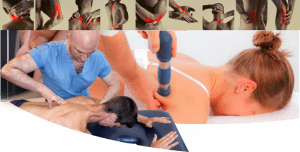August 14, 2023

Muscle soreness is common after exercise, an unexpected strain or even stress. But muscles that feel knotted and tight after to a wide range of conditions affecting all areas of the body.
Myofascial trigger points are irritated areas in tight or stressed bands of muscle. This irritated area can cause shortening of the muscle, which causes main, muscle weakness and impaired movement. These trigger points can be felt as a “knot” – a hard nodule or bump on the muscle.
Trigger poo9nts can develop when muscles are stressed due to causes ranging including injury, repetitive motions, and even poor posture. Surgery can create myofascial trigger points, and so can some diseases. Common, everyday reasons for developing trigger points include bad posture from sitting at a desk or in front of a computer for long periods, and chronic tension, especially in the neck and shoulders.
Myofascial trigger points are not only painful on the affected muscle and surrounding tissues. They can also affect the healthy functioning of just about every system in the body. They can also lead to bowel and urinary problems and even heart palpitations. If the trigger point affects a nerve, numbness and tingling can occur.
Trigger points can also affect circulation by compressing blood vessels, causing changes in skin temperature and color. Located near lymph glands, they can cause swelling and problems with the movement of lymph fluid throughout the body. Trigger points can play a role in many chronic conditions including fibromyalgia, temporomandibular joint syndrome (TMJ), sciatica, and restless leg syndrome.
Trigger points have both a localized and a referred pain component. Trigger points can be found by toring changes in the body’s electrical activity.
Trigger points can generally be easily identified by the telltale knot that can be as hard as a golf ball, found when pressing on a sore or stiff muscle. When pressed, pain can radiate outward from the tight knot into find, especially if they’re hidden behind a bone or a large rigid muscle – but massaging the area can help find the point.
Myofascial therapy specialists have identified three different kinds of trigger points. A primary trigger point is the origin of the problem – a strained muscle in the neck from sitting too long at a computer, or a calf muscle overworked at the gym.
If that first strained muscle is left untreated, other muscles step up to compensate. To avoid pain in a strained calf muscle, the muscles in the thigh and knee must work harder and take more strain as a result. These muscles can develop secondary trigger points as a result of compensating for the original injury or strain. Sorting out which trigger points are primary and which are secondary can be a challenge, since pain can shift, but skilled body workers and therapists can easily identify and treat them through a variety of practices for myofascial release..
A third kind of trigger point, the satellite trigger point, appears in a referral zone of the primary point. Satellite trigger points can occur in places distant from the original point.
Whether primary or secondary, active trigger points cause pain not just on movement or to different places, which can then develop their own secondary trigger points.
Latent trigger points can also be primary or secondary. While active trigger points cause pain while at rest, latent ones cause pain only when rubbed or pressed. These trigger points can remain hidden and persist long after apparent recovery from the original strain or injury.
Although these trigger points can go unnoticed for long periods, they can still affect the surrounding tissues and nerves in the same way as active trigger points. Latent trigger points can be responsible for pain, circulatory issues and digestive problems that have no obvious cause.
Whether primary or secondary, active trigger points cause pain not just on movement or to different places, which can then develop their own secondary trigger points.
Latent trigger points can also be primary or secondary. While active trigger points cause pain while at rest, latent ones cause pain only when rubbed or pressed. These trigger points can remain hidden and persist long after apparent recovery from the original strain or injury.
Although these trigger points can go unnoticed for long periods, they can still affect the surrounding tissues and nerves in the same way as active trigger points. Latent trigger points can be responsible for pain, circulatory issues and digestive problems that have no obvious cause.
Because myofascial trigger points can be the cause of many cases of chronic pain, joint and circulato be taken seriously and treated promptly by a qualified practitioner.
Myofascial trigger point therapy, or myofascial release, is offered by a wide range of bodyworkers including certified massage therapists, chiropractors, and orthopedic specialists. Trigger point therapy can include gentle massage, manipulations and applications of heat and pressure and a variety of other modalities for myofascial release.
If left untreated, myofascial trigger points can become chronic – a condition called myofascial pain syndrome. Myofascial pain syndrome can have long-term effects on the muscles, joints and organs. Early diagnosis and trigger point therapy can ease pain, restore flexibility and keep the body moving as it should.
Dr. Lev Kalika is a world-recognized expert in musculoskeletal medicine. with 20+ years of clinical experience in diagnostic musculoskeletal ultrasonography, rehabilitative sports medicine and conservative orthopedics. In addition to operating his clinical practice in Manhattan, he regularly publishes peer-reviewed research on ultrasound-guided therapies and procedures. He serves as a peer reviewer for Springer Nature.
Dr. Kalika is an esteemed member of multiple professional organizations, including: